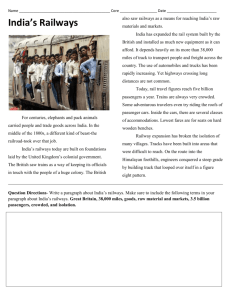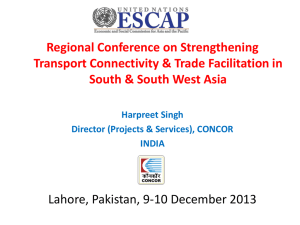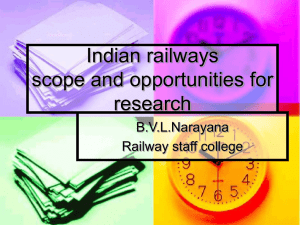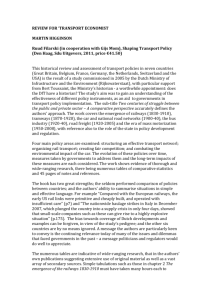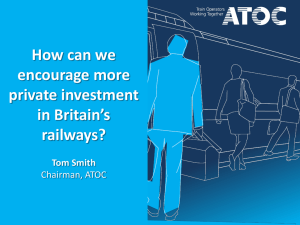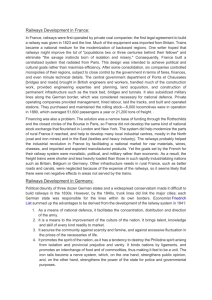Competition in Rail Freight Transport : The Case of Indian
advertisement
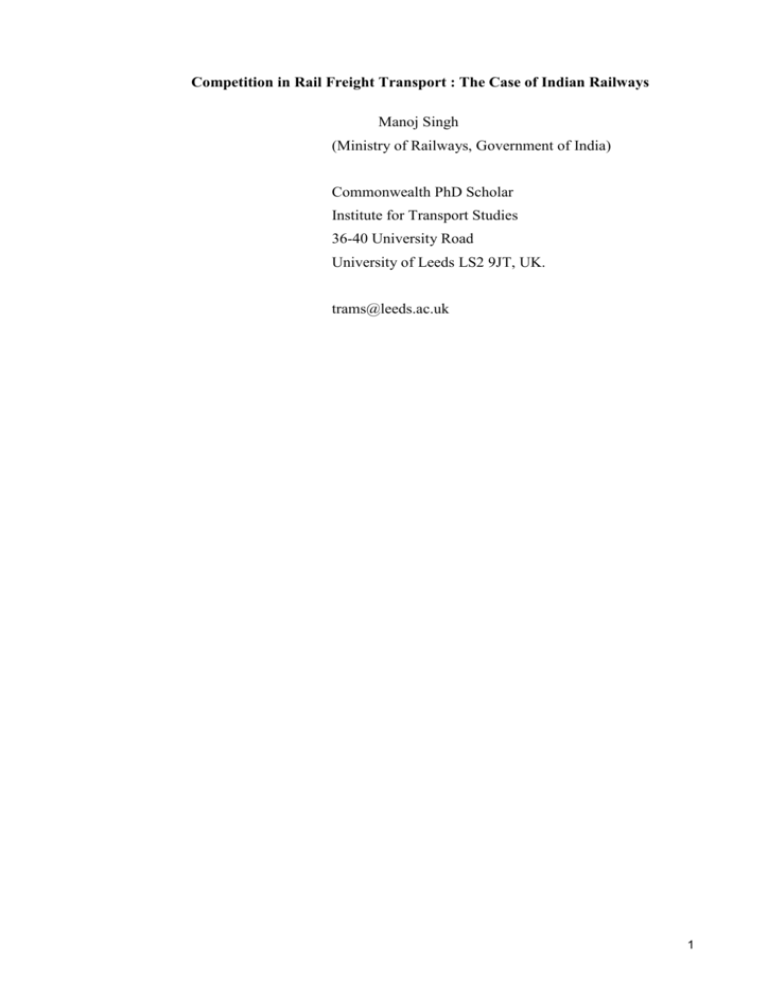
Competition in Rail Freight Transport : The Case of Indian Railways Manoj Singh (Ministry of Railways, Government of India) Commonwealth PhD Scholar Institute for Transport Studies 36-40 University Road University of Leeds LS2 9JT, UK. trams@leeds.ac.uk 1 Abstract This paper analyses the policy followed by the Indian Railways in opening up its intermodal freight segment to competition. This approach attempts to promote competition within the existing structure of integrated monopoly operation. The paper reports on a survey carried out after the policy announcement amongst new entrants to explore the principal barriers to competitive entry and draws some tentative conclusions about the Indian Railway model of deregulation. Access to land for terminals and uncertainty of haulage charges have emerged as crucial barriers although they have not deterred entry. The principal advantage of this model is ease of implementation but one possible constraint is the limited possibility of cost reduction. 2 1. Introduction Introduction of competition in railways has been a matter of considerable interest. Whilst this has already progressed in Europe on the directives of the EU as well as in North America after deregulation, there are many countries like India and China where little progress has been made. There have been some thoughts on how this may be done in the Chinese railways (Rong and Bouf, 2005; Pittman, 2004). It has been suggested that a combination of vertical and horizontal separation may be employed. There are also reports of constraints of deregulation followed in some other economies like Australia (Everett 2006). In this respect, the attempt by Indian Railways to introduce competition in the intermodal segment of freight traffic is quite significant from both national and international perspectives. For the Indian economy which is one of the fastest growing in the world, railways still have a relatively high share of the freight and passenger market. Any impact on its competitiveness has a downstream impact on many sectors of the economy. Due to the rapid globalisation of the Indian economy, the intermodal sector has assumed greater significance as it involves transport connectivity between the ports and the hinterland. Internationally, this process is of significant interest, due to the lessons learnt and transferability of the experiment across other economies. The structure of this paper is as follows. In the following section 2, we describe the process adopted by the Indian Railways. In section 3, we briefly discuss the approaches to introducing competition in the rail industry and the importance of barriers to entry. In section 4 we discuss the initial results from our survey amongst the entrants in India and in section 5 we draw some conclusions about the Indian Railway model of competition. 3 2. Background and the Indian Railway Approach The supplier of rail transportation in India is the Indian Railways (IR), a vertically integrated monopoly service provider owned by the government. Run as a departmental undertaking, it is one of world’s largest railways with over 63,000 route-km and just under 1.5 million employees (Government of India 2006a). Early in 2005, there was a policy announcement of allowing competition in the intermodal sector. The Minister of Railways while announcing the opening of the sector to new players stated in the Parliament: “With the globalization of the Indian economy and spurt in imports and exports, the container traffic is expected to grow exponentially. It has been assessed that growth will be around 15%. In order to meet the growing demand for container trains, organizations other than Concor [the incumbent operator] would also be considered for movement of container traffic.” (Government of India 2005a). 2.1.Corporatization: An Initial Success Container movement by rail was started by Indian Railways in 1981 with the setting up of the first rail based inland container depot (ICD) in Bangalore. The network of ICDs was expanded by adding six more terminals in the next six years. All the operations involved in intermodal movement of containers from the ports to the inland locations including road bridging were done in-house by the Indian Railways. The growth of this segment of traffic on the Indian Railways and its impact on the development of maritime traffic in Indian ports was however, not found adequate. The Railway Reforms Committee in its report recommended to set up a separate organization to promote containerization in India. Container Corporation of India (Concor) was formally set up in 1988 as a public sector company fully owned by the Government of India. It commenced operations in 1989 at which stage Indian Railways transferred all ICDs and container related business to 4 Concor. It not only increased rail share of containers but also helped in the overall growth of containerisation and inland penetration of containers. Total export-import (exim) containers handled by Concor has increased from less than 100,000 TEUs 1 in 1991-92 to 1.37 million TEUs in 2004-05 (figure 1). This performance looks even better when contrasted with the growth in container handling during 1981-82 to 1989-90 prior to corporatisation. Figure 1 From the 7 Inland Container Depots (ICDs) it took over from Indian Railways at inception, Concor has now expanded the network to more than 40 ICDs. Its contribution in developing supporting infrastructure through related agencies like the shipping agents, road transporters, customs authorities in providing a seamless multimodal link for export-import containers from port to hinterland had been widely recognised by the industry in India. During the same period, its turnover increased from Rs 500 million ( $ 11 million) to more than Rs 1800 million ($ 40 million). The success of corporatization can be explained by strategies adopted by Concor like outsourcing of terminal activities, greater customer-orientation, focussed approach, commercial outlook and lack of bureaucratic hindrances leading to faster and decentralized decision making which would not be possible if it were part of the integrated railway. Two more factors are also commonly cited as reasons for its success – support from its owner-promoter, the Indian Railways and a monopoly status. The support from Indian Railways took various forms like access to railway land for setting up terminals on very concessional terms, allowing trained manpower from Indian Railways to work in Concor on deputation basis and overall support in dealing with other arms of the 1 TEU or twenty foot equivalent unit is the unit for container transport. 5 government like the Customs and ports whose cooperation was crucial for the initial success of the company. A monopoly status enabled Concor to be the only organization to offer rail-based container transport in India which helped in protecting its profit margins and resulted in Concor becoming a highly profitable company. 2.2.Recent Trends in Container Handling Container traffic at Indian ports has seen impressive growth of over 15 percent per annum during the five years up to 2003-04 (Government of India 2005b). The handling of containers at Indian ports increased from 0.7 million TEUs in 1990 to 3.9 million TEUs in 2003-04 and is expected to grow to 14 million TEUs by 2014-15. Of this the containers carried by rail is expected to grow to 4.2 million TEUs or around 30% in the same period (RITES 2005) (figure 2). Figure 2 In the recent past, however, Concor has come in for a fair amount of criticism from trade and industry for its inability to evacuate containers, especially from Jawaharlal Nehru Port (JNPT) which accounts for more than 50 percent of India’s container traffic. Against the requirement of evacuating 4000 containers per day, rail evacuation has been to the extent of around 1000 containers per day. The spill over is cleared by road which is not a preferred option due to environmental and cost considerations. In particular, the monopoly status of Concor has been criticized and cited as one of the principal reasons for the less than satisfactory performance in evacuation of containers. In a recent report, “Diagnostic study of JNPT” (Mitra 2005), it has been recommended that there should be at least one competitor to Concor in order to make container movement by rail more customer-oriented. A committee set up by Government of India had also 6 reported a number of representations against high freight rates charged by Concor (Railway Fare and Freight Committee 1993). The business model for Concor however, does not give it total control of its output. The intermodal sector in India closely resembles the wholesaler model (Moyer and Thompson 1992) with the notable exception that Concor is a monopoly retailer. Apart from the operations in the container terminals which are totally under Concor’s control, it has control on the supply of wagons which it now increasingly owns. But the haulage of container trains is undertaken by Indian Railways who provide both locomotives and track capacity. Capacity on the main trunk routes of Indian Railways has been also considered a major constraint on the evacuation of containers. It is estimated that the actual utilization on Delhi-JNPT, the principal intermodal corridor is currently close to capacity. The condition is similar on most of the other corridors where container trains face competition for paths with passenger and other freight trains. In view of the scenario portrayed above, in February 2005 the government took the decision to dismantle the monopoly of Concor. As a result of this policy announcement, it is now possible for any private sector entity to enter the sector of rail based container transport. There is no change in policy of maintaining the monopoly of Indian Railway on haulage of trains. This development has received considerable appreciation and enthusiasm from the related segments of trade and industry in India. Subsequently policy guidelines were issued in January 2006 (Government of India 2006b) which broadly stated the terms and conditions for entry into this sector. The essential elements of the Indian railway model are described below. 7 2.3.Features of Competition Adopted by the Indian Railways Eligibility Criteria The criteria allows entry in the intermodal train operations by Indian public/private sector agencies including Indian registered companies of foreign entities either individually or in joint venture. These companies should have experience in transport related activities. The experience criteria is quite liberal so as to include virtually any organization. It does not rule out own account start ups as manufacturing, trade and commerce and leasing has also been included in the list of eligible experience criteria. There is a minimum revenue or net worth requirement of Rupees 1000 million (£11 million). Consortia formed by companies are also eligible provided each has a minimum revenue or net worth of Rupees 500 million (£ 5.5 million). Rail Access It is required that entrants should have access to an ICD. Recognizing that this may be a constraint for the new entrants, the operator may have a Memorandum of Understanding (MOU) with an existing operator for using its facilities or give an undertaking that it will develop its own rail facility within a period of three years from the date of grant of permission to operate. There have been suggestions that operators may be jointly allowed to set up rail terminals at important locations as well as for independent common user rail user terminals which could be set up by other agencies. Entry Conditions Container carrying rail routes between ports and hinterland (exim routes) have been classified into 4 categories on the basis of existing and anticipated traffic. An operator can enter in one or more sectors. Category I. JN Port/Mumbai Port-National capital region area rail Corridor and/or permission to operate on an all India basis. This includes the existing and future 8 terminals falling in Delhi Area linked to J.N port or Mumbai port. This constitutes the biggest flow of traffic. Category II. Rail corridors serving J.N.Port and its hinterland other than Delhi area. Category III. Rail corridors serving other ports which have less traffic as compared to JN Port. The ports included in this area are Pipavav, Mundra, Chennai/Ennore, Vizag and Kochi and their hinterlands. Category IV. Rail Corridors serving ports of Kandla, New Mangalore, Tuticurin, Haldia/Kolkata, Paradip and Mormugao and their hinterlands. There is another category comprising movement of containers carrying domestic traffic for which the potential operator has to have access to two terminals. Operators can also carry domestic traffic over the four categories mentioned above apart from exim traffic. Registration Fee A non-refundable registration fee of Rs 500 million (£ 5.5 million) for all India operations or for operations in Category I and Rs 100 million (£ 1.1 million) for every other category was to be paid by every operator. This entitled the operators to carry exim or domestic traffic over the routes selected. The purpose of these fees is not clear except to deter frivolous entrants. This is not a franchising fee as this is one amount paid by all operators including Concor. Tenure, Non Exclusivity and Exit Conditions The permission to operate container trains is for a period of 20 years further extendable by 10 years. Other operators may be permitted from time to time on the discretion of the Indian Railways. An operator can seek to exit or transfer its rights to another operator with a three month notice period. 9 Capacity The initial proposal was to have a minimum commitment of traffic from the operators. They had to run respectively seven pairs, four pairs, three pairs and one pair of trains for categories I, II, III and IV. It was also proposed that the operators would be given a period of one year to achieve these volumes. At the end of the first year if there was shortfall in committed traffic, they would be required to pay the haulage charges for the prescribed level of traffic. From the 2nd year onwards, the prescribed traffic commitment would be computed through a system of monthly averages rather than annual average. However, these proposals were not implemented because it was feared that this would deter entry. In the final policy which was announced, the operators were free to run as many trains as possible subject to minimum train loads with no lower limit on number of trains. Elements of Open Access It was suggested that keeping in mind capacity constraints, the number of operators on a particular route may be restricted and where more than one operator can be accommodated on a particular route, selection can be made through the process of commitment to pay higher entry fees as compared to the other operators. In the policy statement, it appears that there are no limits on the number of applicants for each category. In this respect, this is like an open access policy. Entry As per trade reports, 13 companies applied for the licenses to operate in various categories – which indicates considerable interest in the process. It is further interesting to note that 10 companies have bid for the category I showing the dominance of the Delhi-JNPT market in the intermodal movement in India as well as the desire of most of 10 the players to have an all India presence in spite of the higher entry cost. Three operators have chosen to operate in category III and one in category IV. 3. Competition in the Rail Industry There seems to be a convergence of views on the importance of competition in improving the performance of network utilities. It is important to understand that although competition is important, it is not necessary that competition may be sustainable in every utility or in all circumstances (Newbery 2001). The Rail sector is generally regarded as one where promoting competition is more difficult than some other network utilities. One of the useful ways to understand how effectively competition can be introduced in a market is to analyze the barriers to entry which potential entrants are likely to face. Contestability theory suggests the potential for competition can be used as an alternative to regulation as well as to actual competition (Baumol 1982). For this to apply however there are preconditions on the absence of sunk costs and low barriers to entry and exit. If these conditions are met, the threat of competition itself is sufficient to restrain the monopoly without the need for regulation. If there are no entry barriers and the entry and exit of firms can be costless, no policy intervention is required except to remove legal entry restrictions in the industry and take suitable measures to eliminate or reduce entry barriers. Before implementing restructuring of railway organizations, it is therefore necessary to understand the presence of entry barriers. The extent of the barriers in the rail industry depends on what part of the industry we are looking at. Taking the infrastructure first, there are large sunk costs which are a very formidable entry barrier (Nash and Preston 1992). As the cost of installing the network is very high, larger the length of the network, more serious is the entry barrier. In the other part of the industry i.e operation of trains there are economies of scale and density which can make new entry less 11 attractive. The evidence on economies of scale is not as strong as the evidence on density. The study of the US railways reported returns to scale of 0.98 and returns to density of 1.76 (Caves et. al. 1985). A recent study of the railways in Britain have found a value for returns to scale of 0.68 and returns to density of 2.85 (Smith 2006). There is no similar econometric study on the Indian Railways but with freight trains being almost exclusively run as unit trains, it may be possible to assume that economies of density are quite high. The presence of such pronounced barriers to entry make any efforts to introduce competition very difficult without extensive restructuring. The theoretical justification of separation of infrastructure and operations is provided by the theory of contestability. With the benefit of hindsight, it is possible to look at British rail privatization and restructuring to illustrate the theory as well as empirical aspect of barriers to entry. Starkie (1986) was one of the first to suggest the separation of the monopoly element so that on track competition could be made possible. Nash and Preston (1992) drew attention to significant barriers to on-track competition. Where tracks are owned by a competing firm, time-tabling and price of access could be two very critical barriers. It would be possible for this firm to design a time-table which gives it access to not only the most profitable timings but possibly also to block the competitor by filling up all the slots. On the pricing of access there is dilemma between charging marginal cost which may not compensate the incumbent or charging higher than marginal pricing which may lead to the owner of the track being in an advantageous position as it can charge higher for some services. Access to shared infrastructure and terminals, ownership and maintenance of rolling stock and management and training of crew are some important barriers irrespective of whether competition is of on-track type or through competitive tendering. The cost of training 25000 drivers of British Rail itself was equivalent to adding a barrier of 0.5 billion pounds (Nash and Preston 1992). The sunk cost of 12 advertising and promotion, expectation of a strong response from incumbent, more difficult access to investment capital and threat of predation on part of the incumbent would be additional barriers to be overcome by new entrants. Brewer (1996) analysed the extent to which the rail freight markets were actually contestable at the onset of British rail privatization. The Railways Act 1993 created three geographically based trainload freight businesses out of former BR ‘Train Load Freight’ profit centres. A number of separate freight companies with their own rolling stock and portfolio of customers were created as part of the process. Brewer carried out a survey of rail freight users, stakeholders and expert opinion to determine the existence and importance of 23 barriers to entry. The survey pointed out that respondents generally believed that significant barriers to entry existed. The barriers to entry which Brewer included in his survey could be categorized into the following main groups. track access charges : perceived level, method of charging. traction/rolling stock : availability/cost meeting technical formalities : technical restrictions by Railtrack, cost/time in obtaining safety cases/licenses resource availability : like trained drivers/manpower incumbency advantages : economies of density in favour of incumbent, advantage of experience incumbent strategies : responsive pricing, price-cutting, policy related : limited availability of track access grants, freight facility grants. Of these, barriers which were rated to be the highest were track access charges, technical formalities and incumbency related. Whiteing and Brewer (1998) confirmed the presence of these barriers when they interviewed the actual entrants. To some extent all the barriers were found in practice. Operators had success in recruiting staff but undertook costly training exercises. Entry 13 by two new operators (Direct Rail Services and National Power) found profitable entry possible due to high mark ups by the monopoly operator. Additional difficulty of making a safety case costing several millions of pounds and management time was also reported. However, the price and availability of paths was found to be most contentious by Fowkes and Nash (2004), who also recommend improved functioning of labour and asset markets in the rail industry like providing train crews and rolling stock of existing operators at regulated prices in order to promote effective competition. 4. Barriers to Entry in the Intermodal Freight Sector in India A survey of the new entrants into the newly opened freight sector was carried out in India in July and August in 2006. In-depth semi-structured interview was the preferred survey instrument chosen due to its advantage in getting responses in complex and dynamic situations. For this reason this approach was considered more suitable than a questionnaire survey. Out of the 13 new entrants, it was possible to interview 11. CEO or project directors who were directly involved in launching these projects were interviewed. Most of the entrants were in related businesses. Unrelated diversification was the reason given by only one of the entrants. Most of the entrants found the initial conditions of entry fairly simple and straightforward. 4.1.Perception of Barriers to Entry The entrants were asked to state the most important difficulties they expected to encounter in the process of entry. This was followed by a list of 21 barriers which were listed on the basis of an initial analysis of the industry. The respondents were asked to rank them on a scale of 1 to 5. The result of the survey is given in table 1. Most of the entrants considered these factors to be barriers to entry. Table 1 14 Terminals. The most significant barrier emerging from this survey was the process of getting land for building terminals. All the entrants stated that this was a significant barrier. Land is difficult in the major urban centres because of high cost as well as land regulations making it difficult to get big chunks of land for commercial purposes. For example in the greater Delhi area which is one of the biggest container generating areas, there are already six Inland Container depots (ICDs) run by Concor. and other private agencies (Government of India, 2006c). The setting up of terminals is regulated by the Minsitry of Commerce through its Interministerial Committee on infrastructure. It stipulates a minimum requirement of four hectares of land for setting up a new ICD. The biggest ICD in the greater Delhi area which is also India’s biggest ICD is Concor’s facility at Tughlakabad in North-western Delhi which has an area of 44 hectares. In this respect, Concor’s large network of terminals in most of the important locations has been identified as an important barrier by all the entrants. Out of the 205 functioning or under implementation ICDs or container freight stations (CFS) in India, 49 are by owned Concor (Government of India, 2006c). All but three Concor terminals are connected by rail where as the overwhelming majority of the remaining ones are road-fed. Only two of the entrants has a rail-fed ICD. All the others have to make fresh investments in new terminals or look for converting some of the existing ones after acquiring them. However, the policy recognizes the difficulty in this process and provides a period of three years for new entrants to develop these facilities. Haulage Charges Changes in the haulage charges levied by the Indian Railways was ranked as the second most important barrier. More than the level of charges, it was the frequency of change which was perceived to be a higher barrier. This perception has been strengthened owing to a succession of major changes in the structure of rates as well as increase in the rates made effective after the announcement of the new policy. Prior to 25th 15 November, 2005, the rates charged by Indian Railways for haulage of Concor trains were on a per TEU-km basis without any weight considerations. There was no dead weight charge for haulage of wagons which could not be filled up with containers. More importantly, the transfer of wagons from one terminal to another was also free. This has been changed now with such movements being charged. A minimum chargeable lot size per train has also been fixed with a provision for deadweight charging on the difference of actual and minimum requirement. Instead of a flat per unit rate, there is a distance dependent rate. Charging is also by container weight. Over and above this, there is a general increase in the rates. The cumulative impact of all the changes has been to increase the overall rates for movement of containers across all distances although the increase is much higher for lower distances. For example, the increase in rates for a distance of 250 kms is 112% and for a distance of 1500 kms is 33%. The deadweight charging is not perceived to be to be a major barrier although this would impact the entrants as it is unlikely that enough demand would be generated to fill up full trains at least during the initial period of operations. Wagons and Leasing Markets Acquiring wagons in the Indian market where there is no well developed leasing option has also been rated as one of the high barriers. There is capacity constraint for wheels and axles. Most of the entrants have already placed or in the process of placing orders for import of wheel sets and axles. Surprisingly, the large fleet of Concor wagons is not considered to be a very high barrier. The entrants also consider the sunk cost of investing in wagons to be only a moderately low barrier. Capacity Allocation, Regulation and Level Playing Field Uncertainty of operational arrangements in running of trains was perceived to be a high barrier. Lack of clear rules regarding allocation of track paths was reported as a high barrier. Although the policy document (Government of India, 2006b) mentions that the 16 trains would be run in the order in which they are ready in the terminals, there is considerable apprehension about how that is actually implemented. This can have implications for transit time for containers and the competitiveness of the operators. The lack of a separate regulator was, surprisingly, not cited as a major barrier. But perhaps it would be misleading to think that it was not a concern amongst the entrants. Three entrants ranked it 4 and one entrant ranked it 5 thereby showing that at least 40% of the entrants considered lack of a regulator as a barrier. Some of the entrants who did not consider this to be a barrier were concerned that the regulator may slowly increase their influence to bring the operators also under their remit of regulation. However, Concor’s relationship with the Indian railways was not considered by most as a barrier although Indian railways are still the largest shareholder of Concor. In this respect the entrants expect a level playing field from Indian Railways vis-à-vis Concor. This may be due to the perception that Concor is an independent entity which the Indian railways are not likely to favour. This can be considered to be an advantage of corporatization and the subsequent arms length dealing between Indian Railways and Concor which developed in the subsequent period. Economies of Scale and Density Presence of economies of density in rail and terminal operations have been recognised by the entrants as an important barrier. The entrants perceive that Concor gains greater advantage from density than scale in terminal operations. Bigger terminals of Concor do not offer it as much advantage as higher volumes of traffic. Incumbent Response It is interesting to note that the entrants do not recognize Concor to be a source of major entry barrier. In spite of a considerable head start, it is not perceived that Concor’s prior experience in dealing with Indian Railways and running its own terminals or its links with shippers will cause any serious difficulties. In fact, many of the entrants consider 17 this to be a source of advantage as they perceive some weaknesses in Concor’s performance which they can exploit. Only six of the eleven entrants perceive that Concor has resources to better respond to changing customer requirements. However all the entrants perceive that Concor has the ability to respond by undercutting prices and it can cross-subsidize those sectors where it faces competition from new operators. On the whole, entrants are suggesting that while they are not too concerned about the incumbent, there are concerns about availability of assets like land for terminals as well as wagons which may make competition less intense. Regulatory issues like setting up of haulage charges, lack of transparency in allocation of paths and absence of sectoral regulator are the main barriers. Economies of density in favour of Concor is also perceived to be a significant barrier. 5. An Early Evaluation of the Model Chosen by the Indian Railways 5.1.Barriers to Entry Initial response to the policy seems to suggest that there is an overall perception of low barriers to entry. Investment in terminals look to be the most sunk. However in case an operator decides to exit from this sector, it might be possible to sell the land even at a higher rate given the recent trend appreciation in land prices in India. The fixed infrastructure on the terminals like heavy duty pavement in container yard, warehouse, roads and fencing can also have alternative uses say, as a logistics centre. Possibly, the really sunk parts of the investment in terminals are the rail siding and equipment for maintenance of wagons. Depending on the size of the terminal, this investment would range from Rs 200 million (£22 million) to Rs 500 million (£55 million). Equipment in terminals for handling containers could be hired before considering own investment in more sunk items like gantry cranes. The option of entering into arrangement with existing players for terminals makes it possible for an entrant to start operations without investing in a terminal. Investments in wagons can be recovered to a large extent by 18 selling them to another player. Non-asset based costs like safety clearances are also minimal. Only wagons have to be certified by the Indian Railways for which there is a nominal cost. Comparison with entry processes in other rail freight markets would possibly suggest presence of lower entry barriers. In the British case, for instance, there were significant barriers related to availability and cost of locomotives and drivers as well as cost and time in obtaining safety cases (Brewer op cit). This would suggest in terms of promoting new entry, the Indian model seems to be more successful. To what extent easy entry is sustainable over a long run is another question. The difficult aspects of entry in British case like level of haulage charges and allocation of capacity are also areas which are contentious in the Indian case as suggested by our survey. Uncertainty in haulage charges and their level affects the entrants more than the incumbent. The recent increase and restructuring of these charges can be seen either as an exercise in bringing them closer to costs or an attempt to extract monopoly profit. An answer to this question would depend on an analysis of Indian Railway costs which is the attempt in next part of our research. 5.2.Upstream Monopoly Downstream Competition Model Strengths It is pertinent to ask what the main objectives of this model adopted by Indian Railways are and to what extent are they realizable. The three main objectives are : to increase rail share of the containerised transport market; introduce competition in the intermodal freight market and attract private investment in the rail sector (Government of India 2006d ). Taking the last objective, there is no doubt that this scheme has been able to attract investments in wagons. Due to market sensitiveness of the information it was not possible to ascertain the exact number of wagons being procured by various entrants. A 19 broad estimate would be around 3000 wagons which is 50% of Concor’s fleet acquired over a period of fifteen years. There have been other schemes to attract private capital in the Indian rail sector, principally in form of wagons, which have not been as successful. There will also be investment in rail terminals although it is difficult to quantify it at this satge. There is an opportunity for private sector managerial and marketing expertise flowing into the rail sector although in the short run all the key functionaries leading the operations on behalf of the entrants are ex-Concor or Indian Railway people. The objective of increasing rail share may or may not be realised. If the entrants are only able to attract traffic from Concor, there may not be an increase in the overall rail share. However, it is likely that entrants may target segments of traffic which are currently moving by road or moving in bulk form. In the former case there will be net increase in rail share but in the latter case it will depend whether the entrants are able to attract bulk traffic from road and containerize it rather than targeting the bulk traffic being carried by rail. It is the second objective of promoting competition which makes this model more complex than simply an exercise in private-public partnership. There have been many instances of private ownership of assets as well as operation of trains by private sector in publicly owned railways like the pre-privatized British Railway (see for example Dodgson 1994)2. However it is difficult to promote competition while retaining the monopoly status of the incumbent. Success would depend on whether the monopoly operator views the entrant as a competitor to its existing services or as a complement to use its spare capacity and contribute to fixed costs. The current model is an improvement over the previous attempts by public railways to involve private sector in one crucial way. It is in the possibility of elimination of actual 2 Dodgson mentions many cases of private sector involvement like Foster Yeomen running trains using its own wagons and locomotives; Tiger Rail operating some of the services abandoned by BR etc. 20 and potential conflicts between the integrated operator and the entrants. Such conditions of entry which can be called as the 3rd party access or partial separation model where the new entrants are given access along with the integrated operator, there are more chances of competition for the same traffic which prevents effective access to the network for the entrants. In this respect, the Indian Railway model is closer to the open access model with separation of infrastructure and operations where there is no conflict between the separated infrastructure manager and the operators for attracting the same traffic. The essential element which makes this possible and which is distinct in this case is the integrated operator having no interest in that stream of traffic (intermodal traffic in this case). Concor has existed as a separate corporate entity for a number of years and as our survey has also shown, the entrants do not fear conflict of interest with Indian Railways. They largely expect level playing field in haulage rates as well as access to capacity. Corporatization or horizontal separation has therefore increased the chances of success in this model and is therefore the crucial element. Weaknesses However in this process there is hardly any pressure on the integrated monopoly operator to become more efficient. The real reduction in cost of intermodal transport cannot take place unless the rates charged by Indian railways to the operators are brought down. This model has no mechanism for enforcing that. It may be possible collective pressure on the Indian Railways brought by the operators may force it to be more responsive on rates and service quality parameters. An association of the container operators has been formed recently and it remains to be seen whether they will be successful. Although there is expectation of lower conflict between entrants and integrated operator, it cannot be totally eliminated. There can be rivalry for carrying same commodities in wagons if those commodities are amenable to be containerized. The 21 ban imposed by Indian Railways on carriage of coke, coal and iron ore in containers can be seen as an example of this conflict which can aggravate and extend to other commodities. Some of the participants in our survey also pointed out another potential conflict area. This was the financial incentives provided to shippers using the unit trains. If the entrants are targeting the same flows and commodities, it can become a potential area of conflict. Chances of Success The success of the model then depends on whether the mutual benefits of the integrated operator and the new entrants outweigh the potential and actual conflicts. The chances of this model to succeed are high due to a high degree of convergence between the overall objective of the Indian Railways and the incentives of the new operators. The integrated operator is interested in maximizing the rail share of the intermodal freight market in India. It will create situations so that this is accomplished. The areas of conflict and disagreements are likely to be sorted out because of this larger objective. The entrants can also use this in order to take more concessions on freight rates and improvements on service quality issues from the integrated operator. The survey points out to some corrective measures that can be taken on the policy front. Common user terminals may be a possibility made on land leased by Indian Railways. These could be constructed by common user terminal providers. Sharing of terminals amongst the operators may be another possibility. In fact this model has already started emerging. Four new entrants have tied up with Concor to use its terminals till they develop their own terminals. In fact two operators have also started using Concor trains to send containers marketed by them from Concor terminals. Certainty of haulage charges and a more intensive performance regime are also important steps which can be taken to improve competition. 22 Extension of the Model Whether this model of competition can be extended to other segments of freight on Indian Railways, to its passenger segment and finally whether this model is transferable to other railway systems in the world are interesting questions. Further research has to be undertaken for answering these questions but some tentative remarks can be made at this stage. In order for this model to be adopted for other sectors of the Indian Railways, it should be possible to first corporatize that segment. It may be possible for instance to make separate entities for movement of coal and raw materials like iron-ore as well as for commodities requiring specialized movement like steel, cement, petroleum products etc or product wise separation which have some specialist requirements. The immediate question is that of economies of scope between these movements which can vary in different situations. However, in cases where there is no loss of economies of scope and it is possible to restructure horizontally on product basis, the advantage of this model is then the ease of implementation and almost zero cost of restructuring. Corporatization is likely to be a cheaper option than large scale restructuring. Corporatization also offers building up of institutional capabilities in a relatively shorter time frame. Indian Railways’ experiments with this model seem to suggest this. There have been very successful entities in the areas of computerization, passenger amenities and other sectors which were spun off from the integrated railway. However, it might be possible that the corporate entities may have to exist as monopolies for some time before opening up to competition. The Indian Railway approach also raises the question whether it is a viable policy option to do small experimentation with opening access (Nash and Preston op cit) rather than the drastic reforms undertaken in some countries like Britain which run the risk of 23 unsettling existing systems and creating temporary or even permanent systemic problems. References Baumol, W. J. (1982) ‘Contestable Markets: An Uprising in the Theory of Industry Structure’, The American Economic Review, 72(1), pp. 1-15 Brewer, P. R. (1996) ‘Contestability in UK rail freight markets. The economics of open access’ , Transport Policy, 3(3), pp. 91-98. Caves, D.N., Christensen, L.R., Tretheway, M.W. and Windle, R.J. (1985) ‘Network Effects and the Measurement of Returns to Scale and Density for US Railroads’ in Daughety, A. (ed) Analytical Studies in Transport Economics, Cambridge University Press, Cambridge. Dodgson, J. (1994) ‘Railway Privatization’, in M. Bishop, J. Kay and C. Mayer (eds) Privatization and Economic Performance, Oxford University Press, Oxford. Everett, S (2006) ‘Deregulation and reform of rail in Australia: Some emerging constraints’, Transport Policy, 13(1), pp. 74-84. Fowkes, T. and Nash, C. (2004) ‘Rail Privatisation in Britain – Lessons for the Rail Freight Industry’, ECMT, Paris. Government of India (2005a) ‘Budget Speech of the Minister of Railways in the Parliament of India’ Ministry of Railways, New Delhi, February 2005. Government of India (2005b) ‘Economic Survey 2004-05’, Ministry of Economic Affairs. New Delhi. Government of India. (2005c) ‘Container Rail Corridors: An Approach Paper’ Ministry of Shipping, Road Transport and Highways, Report Prepared by Department of Shipping. New Delhi, 2005. 24 Government of India (2006a) ‘Indian Railways Year Book 2004-05’ , Ministry of Railways, New Delhi. Government of India. (2006b) ‘Policy to Permit Various Operators to Move Container Trains on Indian Railways’ Policy paper issued by Ministry of Railways, New Delhi. Government of India. (2006c) ‘Procedures for Setting Up ICDs and CFS’, Ministry of Commerce, New Delhi. Government of India. (2006d) ‘Draft Model Concession Agreement between Indian Railways and Container Operators’, Ministry of Railways, New Delhi. Mitra, A (2005) ‘Competition to Concor’. News report in Business Line August 15 2005, New Delhi. Moyer, N. E. and Thompson, L.S. (1992) ‘Options for Reshaping the Railway’ Policy Research Working Papers 0926, The World Bank, Washington D.C. Nash, C. A., and Preston, J. M. (1992) “Barriers to Entry in the Railway Industry” Working Paper 354, Institute for Transport Studies, Leeds. Newbery, D. (2001) “Privatization, Restructuring and Regulation of Network Utilities.” Cambridge, MIT. Pittman, R (2004), “Chinese Railway Reform and Competition Lessons from the Experience of Other Countries”. Journal of Transport Economics and Policy, 38(2), pp 309-332 Railway Fare and Freight Committee (1993) “Report of the Railway Fare and Freight Committee to the Government of India.” New Delhi RITES (2005) ‘Study of the Operation of Container Trains on Indian Railways’ Report presented to the Ministry of Railways, Government of India, September, 2005. Rong, Z., and Bouf, D. (2005). “How Competition can be introduced in Chinese Railways.” Transport Policy, 12(4), pp. 345-52 Seabright, P et al (2003) “The Economics of Passenger Rail Transport A Survey”. IDEI Report #1 on Passenger Rail Transport, IDEI, Toulouse 25 Shinghal, N (2005) ‘Multimodal Freight Transport Business – A Perspective’, Rail Transport Journal, July-September. Smith, A.S.J. (2006) ‘Are Britain’s Railways Costing Too Much? Perspectives based on TFP Comparisons with British Rail; 1963-2002’, Journal of Transport Economics and Policy, 40(1), pp 1-45. Starkie, D. (1986) “British railways: opportunities for a contestable market.” In C. Mayer, J. Kay and D. Thompson (eds) Privatization and Deregulation: the UK Experience, OUP, Oxford. Whiteing, A.E. and Brewer, P R (1998) ‘Contestability in the UK Rail Freight Market: What are the key barriers to entry and how can they be overcome?’, Transporti Europei, 9(10), pp. 12-22. 26 Table 1 Perceived Significance of Barriers in Intermodal Freight Sector in India Perceived Significance of a Barrier (see key at the end of the table) 1 2 3 4 Getting land for building terminals is very difficult as well as costly in some of the important inland locations 1 4.09 1.22 11 Frequent changes in the haulage charges and the uncertainty associated with it would make it difficult to attract traffic on long term basis 2 3.82 1.25 11 Acquiring wagons is a long process given capacity constraints in the wagon manufacturing industry in India and no opportunity for imports 3 3.36 1.12 11 There are no clear rules for allocation of track paths 4 3.27 1.35 11 Concor has a large number of terminals in important locations 5 3.18 1.25 11 Level of haulage charges levied by the Indian Railways is too high to attract additional traffic from road 5 3.18 1.08 11 Economies of density in rail and terminal operations (Concor has advantage of higher volumes) 7 2.82 0.95 11 Concor can cross-subsidize some sectors in which 8 2.73 1.27 11 Time required in building a terminal is very high 9 2.64 1.43 10 Concor can respond by undercutting prices 9 2.64 1.12 11 There is no separate regulator 9 2.64 1.63 9 Presence of economies of scale in terminal operations (Concor has large terminals where it is possible to reduce cost of handling) 12 2.55 0.93 11 Indian Railways is the largest shareholder of Concor which might affect its relationship with other operators 13 2.45 0.93 11 Concor has a large fleet of wagons 14 2.18 1.54 11 Wagons have few alternative uses 14 2.18 1.54 10 The charging of deadweight charges on the unutilised capacity of the train will make the cost higher for the shipper 14 2.18 1.25 10 Concor has prior experience of running container trains, dealing with Indian Railways and running its own terminals 17 2.09 1.58 8 There are time-consuming formalities by Indian Railways for registration of wagons 18 2.09 1.22 10 There is no market for leasing of wagons 19 1.91 1.66 9 Concor has long standing links with shipping lines and exporters 20 1.64 1.36 9 Concor has resources to respond better to changing 21 1.36 1.80 9 it faces competition from new operators customer requirements Key: (1) Rank of Barrier based on average scores (2) Average score on a scale of 1 to 5 (1 minimum, 5 maximum) (3) Standard deviation of the scores (4) The number of entrants who stated that this was a barrier 27 Figure 1 : Growth of Container Handling by Rail in India 1500000 1250000 TEU 1000000 750000 500000 250000 0 2003-04 2001-02 1999-00 1997-98 1995-96 1993-94 1991-92 1989-90 1987-88 1985-86 1983-84 1981-82 Source: Shinghal (2005) 28 Figure 2: Forecast of Containers Handled by Indian Ports and Carried by Rail 16 12 10 Port Handling 8 6 Transported by rail 4 2 2014-15 2013-14 2012-13 2011-12 2010-11 2009-10 2008-09 2007-08 2006-07 2005-06 0 2004-05 Million TEUs 14 Source: RITES(2005) 29

